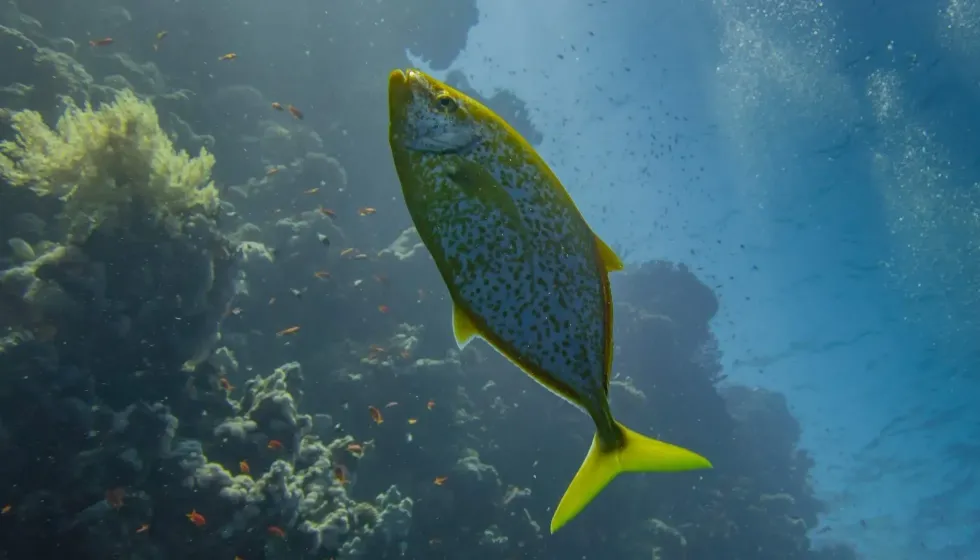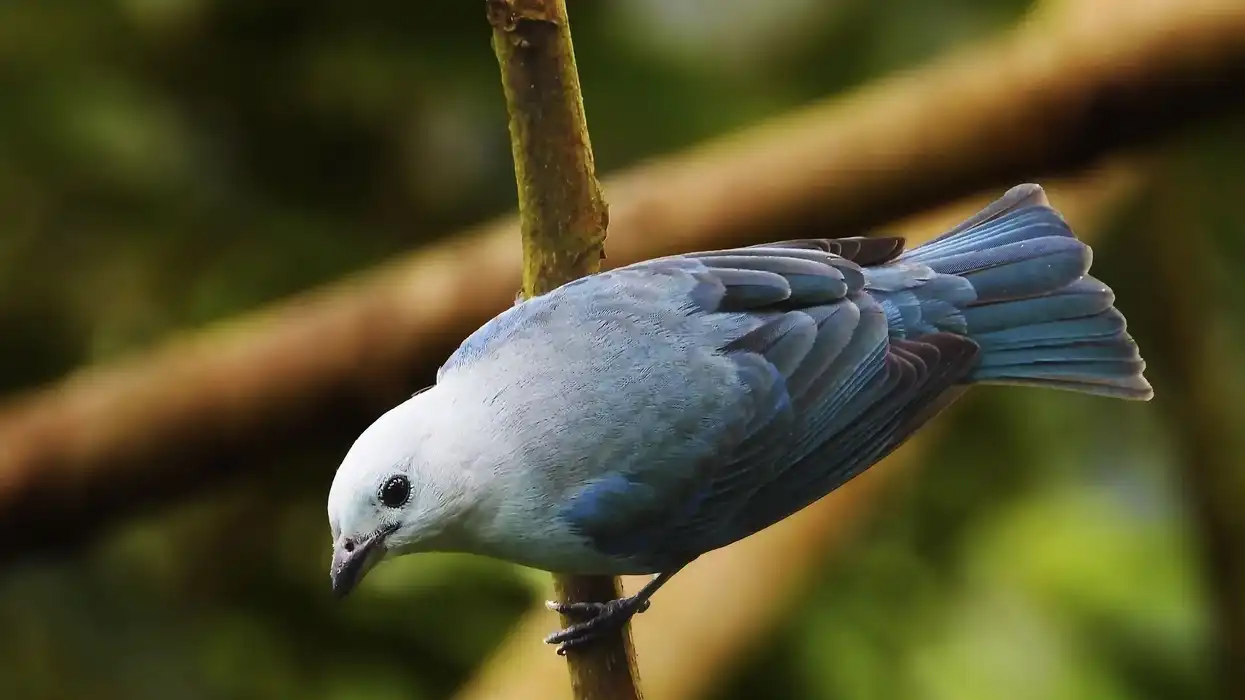Yellow jacks are a common fish species found all over the world, including the Atlantic ocean, the Caribbean, north Gulf of Mexico, West Indies and Brazil. The scientific name of this species is Carangoides bartholomaei, and they belong to the Carangidae family of fish.
They are characterized by their blue-green color, and their large size. They are found in big schools of fish, even during breeding season (summer), when the entire school spawns together at the same time.
They are often caught as table fish, which means that they are caught for consumption. The yellow jack fish taste is considered to be very unique, and extremely tasty to some.
Yellow jacks are also a long-lived species, which means that certain members of this species have been found to live up to 15 years. They are a non-venomous, non-aggressive fish, and have been classified as Least Threatened by the IUCN.
For more relatable content, check out these mantis shrimp facts and ghost shrimp facts for kids.
Yellow Jack Interesting Facts
What type of animal is a yellow jack?
The yellow jack is a species of fish belonging to the Carangidae family and Caranx genus.
What class of animal does a yellow jack belong to?
The yellow jack is a fish that belongs to the class Pisces.
How many yellow jacks are there in the world?
Yellow jacks have a stable and abundant population distribution across the world. However, the exact number of yellow jacks present in the world is not known.
Where does a yellow jack live?
The yellow jack species has a steady population distribution across the world, ranging from the Atlantic Ocean to Bermuda, through the north of the Gulf of Mexico to the Caribbean, the West Indies to Sao Paulo in Brazil. They are also present in certain parts of the eastern Atlantic ocean, specifically at the St. Paul's Rocks.
What is a yellow jack's habitat?
The yellow jack species is found across the Oceans of the world, including the Caribbean and Pacific oceans. They are also found in coastal waters, tropical waters, estuaries, bays and lagoons.
Who do yellow jacks live with?
Yellow jacks are a shoaling species, which means that they are found in big schools of fish. A school of yellow jacks contain an average of 1000 fish.
How long does a yellow jack live?
Yellow jacks are a long-lived species, which means that they have very long lifespans. The average yellow jack fish lifespan is 15 years.
How do they reproduce?
Yellow jacks are oviparous in nature, which means that they reproduce by means of eggs. Males and females of this species release their respective gametes into the open water simultaneously. Fertilization takes place externally. Breeding takes place offshore from the months of February to October. Big groups of 300 fishes are formed and spawning takes place before sunrise.
What is their conservation status?
Yellow jacks have a steady an abundant population distribution. Hence, they have been classified as Least Concern by the IUCN.
Yellow Jack Fun Facts
What do yellow jacks look like?
Yellow jacks are larger fish, with an almond shaped body, with a yellow/silver body with a blue/green tinge. They have large, greenish dorsal fins and a silver underbelly. They have a slightly curved head, and a small lower jaw.
Juveniles are often observed to have many vertical bands on their sides. However, as they mature, these stripes fade away. These are large fish and they have been observed to grow to over 40 in (1 m) in length.
 *We've been unable to source an image of a yellow jack, and have used an image of a blue jack instead. If you are able to provide us with a royalty-free image of a yellow jack,, we would be happy to credit you. Please contact us at hello@kidadl.com.
*We've been unable to source an image of a yellow jack, and have used an image of a blue jack instead. If you are able to provide us with a royalty-free image of a yellow jack,, we would be happy to credit you. Please contact us at hello@kidadl.com.
How cute are they?
Yellow jacks are a large fish species, and are not generally considered to be cute.
How do they communicate?
Yellow jacks communicate through a combination of visual and physical signals. They are known for actively making steady and silent gestures and movements to communicate with one another.
How big is a yellow jack?
A yellow jack is a large fish, that can reach lengths up to 40 in (1 m). This makes them four times larger than drumfish.
How fast can a yellow jack swim?
Jack fish can swim up to a speed of 4.4 mph (16 kph).
How much does a yellow jack weigh?
Yellow jacks have been observed to weigh up to 30.86 lb (14 kg).
What are the male and female names of the species?
There are no specific names for males and females of this species. They are simply referred to as male or female.
What would you call a baby yellow jack?
Baby yellow jacks are simply referred to as juveniles or fry.
What do they eat?
Yellow jacks are carnivorous in nature, and their main food consists of smaller fish such as the clown wrasse, the yellowtail snapper, parrotfish and the bluethroat pikeblenny. They have also been observed to stalk larger fish to forage for their leftovers and scraps left by these fish.
They also have a very close relationship to the spinner dolphin, often feeding on its waste.
Are they dangerous?
No, yellow jacks are not dangerous to humans. They are non-venomous, non aggressive fish. They are a common food fish, eaten across the world.
Would they make a good pet?
Yellow jacks are not commonly kept as pets. They are a commercial fish, often caught for human consumption.
Did you know...
Around the West Indies, yellow jacks have been observed to have certain toxins known as Ciguatera in their blood stream. Ciguatera is an illness that can be transferred to humans if they eat flesh that has these toxins present in them.
As a result, they have been classified as a high risk species in this area, and hence are not normally caught for consumption.
Although these fish mate in pairs, spawning often takes place at the same time for the entire school. They gather in large groups of over 300 fish, spawning at the same time.
When juveniles are born, they are often found near the surface of the water, camouflaged in between jellyfish and seaweed. These juveniles have a green and silver tinged skin color, which allows them to remain hidden among the jellyfish and seaweed.
Even though yellow jacks are a big, meaty species, they are only of very minor economic value. This is mainly because fishermen prefer their larger relatives. They also are a high risk species in some areas, due to which they are overlooked by common fishermen.
Is yellow jack fish good to eat?
Due to their abundance in the ocean and its widespread distribution, they are often caught by fisherman to be sold for human consumption in the market. They are a large and fleshy fish, and have been rated as a fair to good edible fish.
How to find yellow jack fish
Yellow jacks prefer small channels and cuts of water. They are also often found above corals, near underwater structures such as shipwrecks, and sponge gardens. They can also be found in areas where spinner dolphins occur. Since they are a following fish, you can find them stalking larger fish and manta rays.
Here at Kidadl, we have carefully created lots of interesting family-friendly animal facts for everyone to discover! For more relatable content, check out these codfish facts and sucker fish facts pages.
You can even occupy yourself at home by coloring in one of our free printable fishing coloring pages.




 *We've been unable to source an image of a yellow jack, and have used an image of a blue jack instead. If you are able to provide us with a royalty-free image of a yellow jack,, we would be happy to credit you. Please contact us at hello@kidadl.com.
*We've been unable to source an image of a yellow jack, and have used an image of a blue jack instead. If you are able to provide us with a royalty-free image of a yellow jack,, we would be happy to credit you. Please contact us at hello@kidadl.com.



